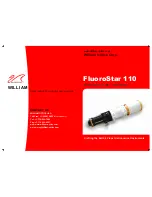
15
optical tube’s eyepiece. If you have aligned your
finder, you will you see the object in your eyepiece.
Focus: Look through the eyepiece and practice
focusing on the object you have chosen. The focuser
has a tension knob (25, Fig. 2) that allows the user
to adjust how tight the focuser feels. Experiment
with this knob to discover which adjustments are
comfortable with your viewing style.
Observe the Moon: When you feel comfortable
with the finder, the eyepieces, the locks and the
adjustment controls, you will be ready to try out the
telescope at night. The Moon is the best object to
observe the first time you go out at night. Pick a
night when the Moon is a crescent. No shadows
are seen during a full Moon, making it appear flat
and uninteresting.
Look for different features on the Moon: The most
obvious features are craters. In fact you can see
craters within craters. Some craters have bright
lines about them. These are called rays and are
the result of material thrown out of the crater when
it was struck by a colliding object. The dark areas
on the Moon are called Maria and are composed
of lava from the period when the Moon still had
volcanic activity. You can also see mountain ranges
and fault lines on the Moon.
Use a neutral density filter (sometimes called a
“moon filter”) when observing the Moon. Neutral
density filters are available from Meade as an
optional accessory.
Spend several nights observing the Moon. Some
nights, the Moon is so bright that it makes other
objects in the sky difficult to see. These are nights
that are excellent for lunar observation.
Observe the Solar System: After observing the
Moon, you are ready to step up to the next level
of observation, the planets. There are four planets
that you can easily observe in your telescope:
Venus, Mars, Jupiter and Saturn.
Nine planets travel in a fairly circular pattern around
our Sun. Any system of planets orbiting one or
more stars is called a solar system. Our Sun, by
the way, is a single, dwarf star. It is average as far
as stars go and is a middle aged star.
Beyond the planets are clouds of comets, icy
planetoids and other debris left over from the birth
of our sun (the Oort cloud). Recently astronomers
have found large objects in this area and they may
increase the number of planets in our solar system.
The four planets closest to the Sun are rocky and
are called the inner planets. Mercury, Venus, Earth
and Mars comprise the inner planets. Venus and
Mars can be easily seen in your telescope.
Venus is seen before dawn or after sunset, because
it is close to the Sun. You can observe Venus going
through crescent phases. But you cannot see any
surface detail on Venus because it has a very thick
atmosphere of gas.
When Mars is close to the Earth, you can see
some details on Mars, and sometimes even Mars’
polar caps. But quite often, Mars is further away
and just appears as a red dot with some dark lines
crisscrossing it.
Jupiter, Saturn, Uranus, Neptune and Pluto
comprise the outer planets. These planets, except
for Pluto, are made mostly of gases and are
sometimes called gas giants. If they had grown
much bigger, they may have become stars. Pluto is
made mostly of ice.
Jupiter is quite interesting to observe. You can see
bands across the face of Jupiter. The more time
you spend observing these bands, the more details
you will be able to see.
One of the most fascinating sights of Jupiter are
its moons. The four largest moons are called the
Galilean moons, after the astronomer Galileo, who
observed them for the first time. If you’ve never
watched the Galilean moons in your telescope
before, you’re missing a real treat! Each night, the




































